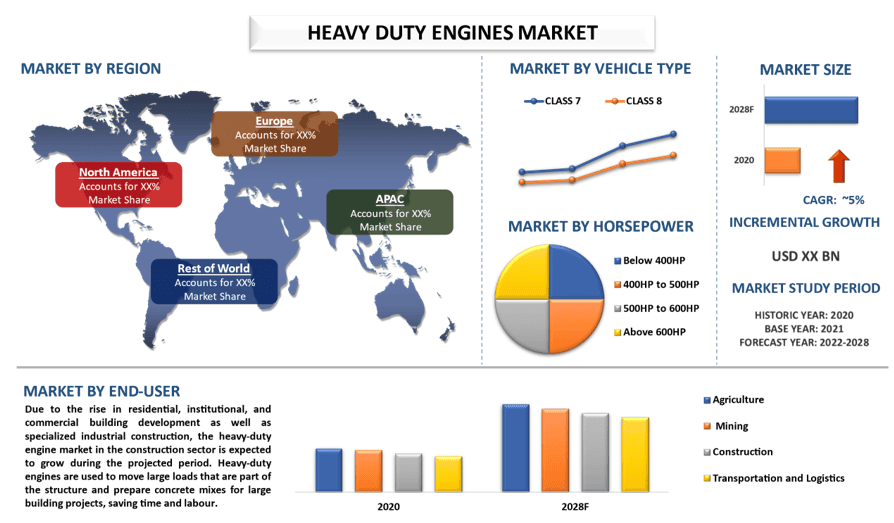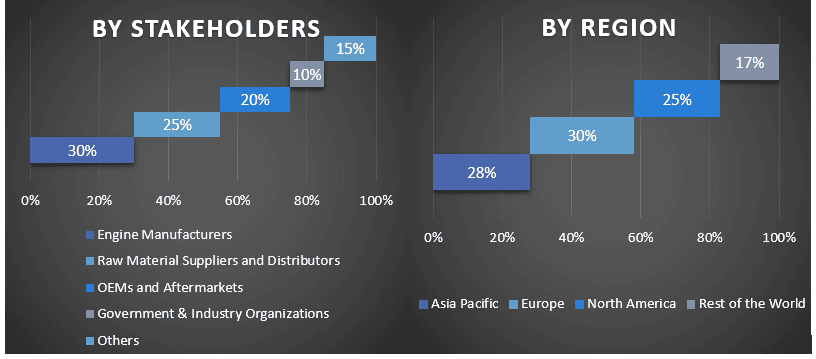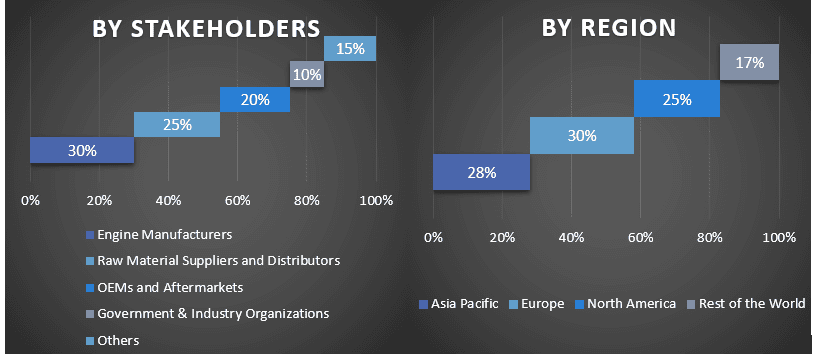Emphasis on Vehicle Type (Class 7 and Class 8); Horsepower (Below 400HP, 400HP – 500HP, 500HP – 600HP, and Above 600HP); End-user (Agriculture, Mining, Construction, and Transportation and Logistics)); and Region/Country

The global Heavy-duty engine market is expected to grow at a significant rate of around 5% during the forecast period. Vehicles with heavy-duty engines are often designed to transport both heavy goods and passengers. Additionally, heavy-duty engines satisfy the need for low speed and great torque to handle a variety of surfaces. Additionally, heavy engines are added to agricultural and construction trucks to increase power rather than speed. Typically, heavy-duty vehicles have a gross vehicle weight of 10,000 pounds or more, and they can only be propelled by powerful engines. The significant market competitors have increased their production rates in response to the growing demand for heavy-engine vehicles.
Caterpillar Inc., Cummins Inc, Isuzu Motors Ltd, Komatsu Ltd, Mercedes-Benz, Volvo Truck, Hino Motors Ltd, Kirloskar Group, Perkins Engines Company Limited, and PACCAR. are some of the key players in the market. Several M&As along with partnerships have been undertaken by these players to facilitate customers with hi-tech and innovative products/technologies.
Insights Presented in the Report
“Amongst Vehicle type, Class 8 category to witness robust CAGR during the forecast period”
Based on type, the market is segmented into class 7 and class 8. Class 8 category is to witness higher CAGR during the forecast period owing to the growing use extensively in transportation, agricultural, and construction equipment, stimulating market growth. Furthermore, Class 8 engine huge trucks are used to haul bulky freight; as a result, these vehicles need a lot of torque to operate at low speeds. Since Class 8 engines have more torque than Class 7 engines, heavy-duty vehicles considerably benefit from them. To accelerate the market’s growth, the leading companies in the industry are also focusing on improving cars.
“Amongst horsepower, the 400HP-500HP to hold a significant share in the market in 2020”
Based on the drive type, the market is categorized into below 400HP, 400HP – 500HP, 500HP – 600HP, and above 600HP. Among these, the 400HP – 500HP to hold a significant share of the market in 2020. The market is predicted to expand because of the rising demand for these engines in automobiles. Weight, aerodynamics, and fuel efficiency become more important for heavy-duty vehicles as engine horsepower increases.
“Amongst end-user, Construction to hold a significant share in the market in 2020”
Based on the end-user, the market is categorized into agriculture, mining, construction, transportation, and logistics. Among these, the construction to hold a significant share of the market in 2020. Due to the rise in residential, institutional, and commercial building development as well as specialized industrial construction, the heavy-duty engine market in the construction sector is expected to grow during the projected period. Heavy-duty engines are used to move large loads that are part of the structure and prepare concrete mixes for large building projects, saving time and labor.
“APAC to hold a significant share in the market”
APAC is anticipated to grow at a substantial CAGR during the forecast period. This is mainly due to the increase in agricultural activities, expansion of the construction companies backed by growing disposable income, and surging per capita spending of individuals in the emerging economies of the region is driving the growth of the market. Moreover, the regional market demand is anticipated to be driven by the expanding transportation & logistics sector in nations like China, Japan, and India. The automobile industry in APAC is thriving thanks to quick urbanization, expanding infrastructure, and a prosperous economy. Product sales will be boosted by the increased number of heavy commercial vehicle replacements and sales of new vehicles.
Reasons to buy this report:
Customization Options:
The global heavy duty engine market can further be customized as per the requirement or any other market segment. Besides this, UMI understands that you may have your own business needs, hence feel free to connect with us to get a report that completely suits your requirements.
1. Market Introduction
2. Research Methodology Or Assumption
3. Market Synopsis
4. Executive Summary
5. Impact Of Covid-19 On The Heavy-duty Engines Market
6. Heavy-duty Engines Market Revenue, 2020-2028f
7. Market Insights By Vehicle Class
8. Market Insights By Horsepower
9. Market Insights By End-user
10. Market Insights By Region
11. Heavy-duty Engines Market Dynamics
12. Heavy-duty Engines Market Opportunities
13. Heavy-duty Engines Market Trends
14. Demand And Supply-side Analysis
15. Value Chain Analysis
16. Competitive Scenario
17. Company Profiled
18. Disclaimer
Research Methodology for the Heavy-duty Engine Market Analysis (2022-2028)
Analyzing the historical market, estimating the current market, and forecasting the future market of the global heavy duty engine market were the three major steps undertaken to create and analyze the adoption of heavy-duty engine markets in major regions globally. Exhaustive secondary research was conducted to collect the historical market numbers and estimate the current market size. Secondly, to validate these insights, numerous findings and assumptions were taken into consideration. Moreover, exhaustive primary interviews were also conducted, with industry experts across the value chain of the global heavy-duty engine market. Post assumption and validation of market numbers through primary interviews, we employed a top-down/bottom-up approach to forecasting the complete market size. Thereafter, market breakdown and data triangulation methods were adopted to estimate and analyze the market size of segments and sub-segments of the industry pertains to. Detailed methodology is explained below:
Analysis of Historical Market Size
Step 1: In-Depth Study of Secondary Sources:
Detail secondary study was conducted to obtain the historical market size of the heavy-duty engine market through company internal sources such as annual reports & financial statements, performance presentations, press releases, etc., and external sources including journals, news & articles, government publications, competitor publications, sector reports, third-party database, and other credible publications.
Step 2: Market Segmentation:
After obtaining the historical market size of the heavy-duty engine market, we conducted a detailed secondary analysis to gather historical market insights and share for different segments & sub-segments for major regions. Major segments are included in the report as vehicle type, horsepower, and end-user. Further country-level analyses were conducted to evaluate the overall adoption of testing models in that region.
Step 3: Factor Analysis:
After acquiring the historical market size of different segments and sub-segments, we conducted a detailed factor analysis to estimate the current market size of the heavy-duty engine market. Further, we conducted factor analysis using dependent and independent variables such as vehicle type, horsepower, and end-user of heavy-duty engine markets. A thorough analysis was conducted for demand and supply-side scenarios considering top partnerships, mergers and acquisitions, business expansion, and product launches in the heavy-duty engine market sector across the globe.
Current Market Size Estimate & Forecast
Current Market Sizing: Based on actionable insights from the above 3 steps, we arrived at the current market size, key players in the global heavy duty engine market, and market shares of the segments. All the required percentage shares split, and market breakdowns were determined using the above-mentioned secondary approach and were verified through primary interviews.
Estimation & Forecasting: For market estimation and forecast, weights were assigned to different factors including drivers & trends, restraints, and opportunities available for the stakeholders. After analyzing these factors, relevant forecasting techniques i.e., the top-down/bottom-up approach were applied to arrive at the market forecast for 2028 for different segments and sub-segments across the major markets globally. The research methodology adopted to estimate the market size encompasses:
Market Size and Share Validation
Primary Research: In-depth interviews were conducted with the Key Opinion Leaders (KOLs) including Top Level Executives (CXO/VPs, Sales Head, Marketing Head, Operational Head, Regional Head, Country Head, etc.) across major regions. Primary research findings were then summarized, and statistical analysis was performed to prove the stated hypothesis. Inputs from primary research were consolidated with secondary findings, hence turning information into actionable insights.
Split of Primary Participants in Different Regions

Market Engineering
The data triangulation technique was employed to complete the overall market estimation and to arrive at precise statistical numbers for each segment and sub-segment of the global heavy-duty engine market. Data was split into several segments & sub-segments post studying various parameters and trends in the areas of type, drive type, and application in the global heavy duty engine market.
The main objective of the Global Heavy-duty Engine Market Study
The current & future market trends of the global heavy duty engine market were pinpointed in the study. Investors can gain strategic insights to base their discretion for investments on the qualitative and quantitative analysis performed in the study. Current and future market trends determined the overall attractiveness of the market at a regional level, providing a platform for the industrial participant to exploit the untapped market to benefit from a first-mover advantage. Other quantitative goals of the studies include:

Customers who bought this item also bought